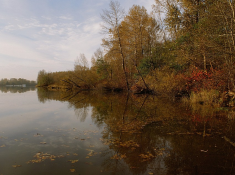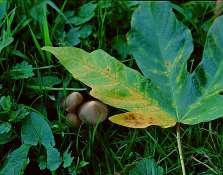I think he is talking about scanning. As in one does the scan, the shadows look very dark so one boosts the shadows in post much as one would with a digital camera file. From my own experience my scans from Provia could have the shadows boosted at least as well as say files from the Leica M8 I used to have (but with less noise). The downsides are very poor shadow resolution IMHE. However there is a kicker. A scanned slide always seems to look more contrasty to me than it does when projected where the contrast looks fairly natural. To some extent boosting the shadows in post is only making the file look someway towards how it would look projected. Therefore what looks like an amazing shadow recovery is perhaps not that amazing really. Personally I reckon there is around 7 maybe 7.5 stops in Provia once recovered in post, I don't have any proof of that but would take some convincing of anyone claiming much more.
I think you are right there. He was talking about recoverable shadow information. That is like pulling up the shadows in a digital raw file. Of course if you pull up the information in the very deep shadows and push them up into Zone V the result will be unpleasant. But it is there and in projection it might effectively be in Zone 0, while pulling it up into the barely visible range in digital (or any other available) post could give a meaningful result.
Flatbed scanners will have problems scanning the high densities in slides, but quality scanners and digicam scanning can get to that information.
I haven't got the experience to say if that will technically result in 10 stops, I would have guessed less, but with what little I have played around in the last two years I notice here on Photrio that there is a lot of prejudice in what is said about slides.
You said earlier that negative film does not have any inherent qualities that give it more dynamic range than slide film. That is absolutely incorrect and it is you who needs to be educated so I explained earlier that it does.
A film with a wide dynamic range does not require precise exposure as slide film does and a thus a film with a range of 10-12 stops would not require such a precise exposure as slide film does. It would have several stops of headroom to allow for exposure errors, to produce a quality image, nearly what negative film does, for almost any high brightness range scene one might encounter.
Slide films do not have such headroom due to much less range than negative film.
IMHO slide film itself has more reserves than you believe. Imagine a C41/RA4 system where the exposure time in the enlarger is fixed. You can only enlarge with 15s. And all the sudden the latitude of your in camera exposure goes away. It'd be the same as shooting slide. Does it mean you film has no inherent latitude?
I wrote above what amazing latitude Provia 400x has when developed as a negative. E.I50 vs E.I. 400 made not too much a difference in the resulting densities. Further more you can easily overexpose Provia by a stop or underexpose by two stops. Just tell your lab that you did so and have it pull or push processed and you'll end up with a perfect slide. If what you write above was true this would be impossible. That is the equivalent of changing exposure time in the enlarger step.
I'm sure that slide films have not been optimised as much as negative films towards latitude, because it isn't required to such a degree. But the lack of it mainly comes from the type of processing. The contrast of slide is necessary because that is the contrast you wand and need in the final product.
I have taken pictures in the harsh sun of Usbekistan recently and was surprised how much dynamic range Provia 100F has. And I even managed to shoot a high contrast scene in opposing light with deep shadows using Velvia 50. I took and incident light reading in a shaded area of the scene. I assumed the sky would be blown out, but it was ok. Of course there where no clouds. Blue sky is quite dark and works great with slide.
I took evening shots with Provia 400x with the same metering but slightly overcast sky and it completely blew out. I'm still learning. But it doesn't mean it cannot be done and the discussion about slide could be of better quality.
And another point I'd like to make about over and underexposure of negative film: On the one hand we keep on being told how great and important the orange mask is to neutralise dye impurities. And or course slide doesn't have that. But in some documents about Vision3 film Kodak says that under and overexposure leads to colour inaccuracies (the curves don't fit as well anymore is probably what they said). That means if you want to use negative film to its maximum potential you should expose spot on, just as you do with slide film.
In this age, for most people, if they wanted to have perfectly calibrated colour they wouldn't shoot film in the first place. I don't think people look at slides and think that they wished those dye impurities were corrected. Isn't that film look the whole point for still using it? So then I don't understand many of the arguments made agains slide. Yeah, you have to expose it just right, fair enough...







